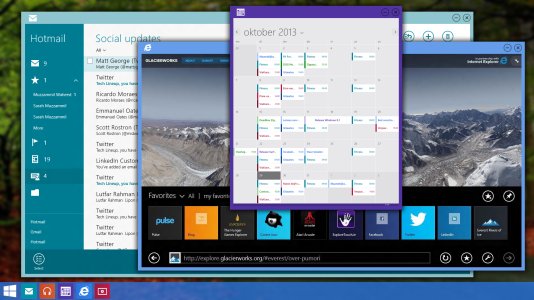- Oct 15, 2012
- 200
- 0
- 0
Well, I don't think it should be done exactly like this, but I just wanted to show a little idea I had.
In my very humble little opinion... the desktop and Modern UI aren't really that different. They're both interfaces with shortcuts/icons, a taskbar and dedicated apps. I really think it shouldn't be so hard to merge the two.
Let's take a look at the differences and similarities:
- Desktop has a file explorer and files can be stored on the "main screen" (desktop). This isn't possible in Modern UI.
- Desktop has a taskbar at the bottom, Modern UI has one hidden on the left side of the screen.
- Modern UI is optimized for touch, desktop isn't.
- You can have multiple windows with different sizes open on the Desktop. In the Modern UI, all apps are fullscreen, although they can be snapped.
If we merge these differences and similarities, what would we get? I think it'll look something like this:

Basically, this is the Modern UI startscreen with a taskbar at the bottom. Here, the active apps will be shown; just like the "old" bottom-bar on the desktop and the hidden taskbar to the left in Modern UI. If you open a new app, or tap one of the apps in the taskbar that are already running, the start menu will disappear, and the window of the app will pop up, just like the current desktop:

Now, if Microsoft would come up with something like a bigger border around these apps, it would be pretty easy to resize or drag them when you're using touch-input. It would take away ALL the criticism like "it feels awkward with mouse and keyboard" and "I don't want fullscreen apps". If you touch the background or tap the Start button, the open windows all minimize and the Start Menu reappears (like screenshot 1).
One of the only things I haven't thought about (yet) is the file explorer... It might be possible to store individual files and folders on your startscreen (like tiles), but I'm not sure about that yet. Another solution might be a very sophisticated, deeply integrated seperate "file explorer-app" that you can boot up just like all other apps.
Tell me what you think! This was made in 30 minutes, so it's not THAT thought out, but I really think Windows 8 offers an opportunity for something like this.
In my very humble little opinion... the desktop and Modern UI aren't really that different. They're both interfaces with shortcuts/icons, a taskbar and dedicated apps. I really think it shouldn't be so hard to merge the two.
Let's take a look at the differences and similarities:
- Desktop has a file explorer and files can be stored on the "main screen" (desktop). This isn't possible in Modern UI.
- Desktop has a taskbar at the bottom, Modern UI has one hidden on the left side of the screen.
- Modern UI is optimized for touch, desktop isn't.
- You can have multiple windows with different sizes open on the Desktop. In the Modern UI, all apps are fullscreen, although they can be snapped.
If we merge these differences and similarities, what would we get? I think it'll look something like this:

Basically, this is the Modern UI startscreen with a taskbar at the bottom. Here, the active apps will be shown; just like the "old" bottom-bar on the desktop and the hidden taskbar to the left in Modern UI. If you open a new app, or tap one of the apps in the taskbar that are already running, the start menu will disappear, and the window of the app will pop up, just like the current desktop:

Now, if Microsoft would come up with something like a bigger border around these apps, it would be pretty easy to resize or drag them when you're using touch-input. It would take away ALL the criticism like "it feels awkward with mouse and keyboard" and "I don't want fullscreen apps". If you touch the background or tap the Start button, the open windows all minimize and the Start Menu reappears (like screenshot 1).
One of the only things I haven't thought about (yet) is the file explorer... It might be possible to store individual files and folders on your startscreen (like tiles), but I'm not sure about that yet. Another solution might be a very sophisticated, deeply integrated seperate "file explorer-app" that you can boot up just like all other apps.
Tell me what you think! This was made in 30 minutes, so it's not THAT thought out, but I really think Windows 8 offers an opportunity for something like this.

